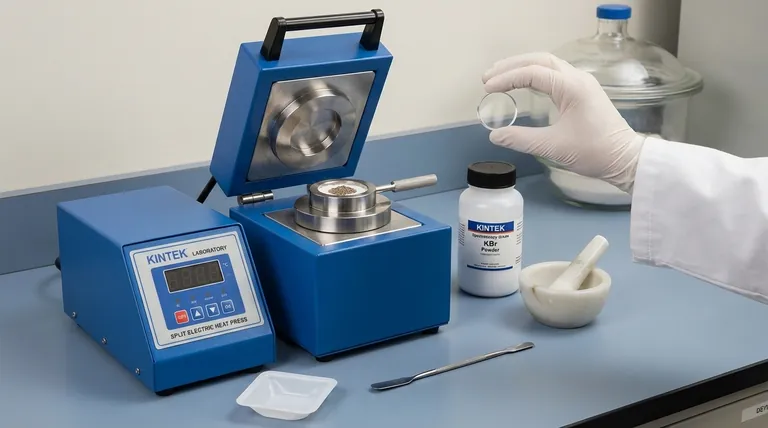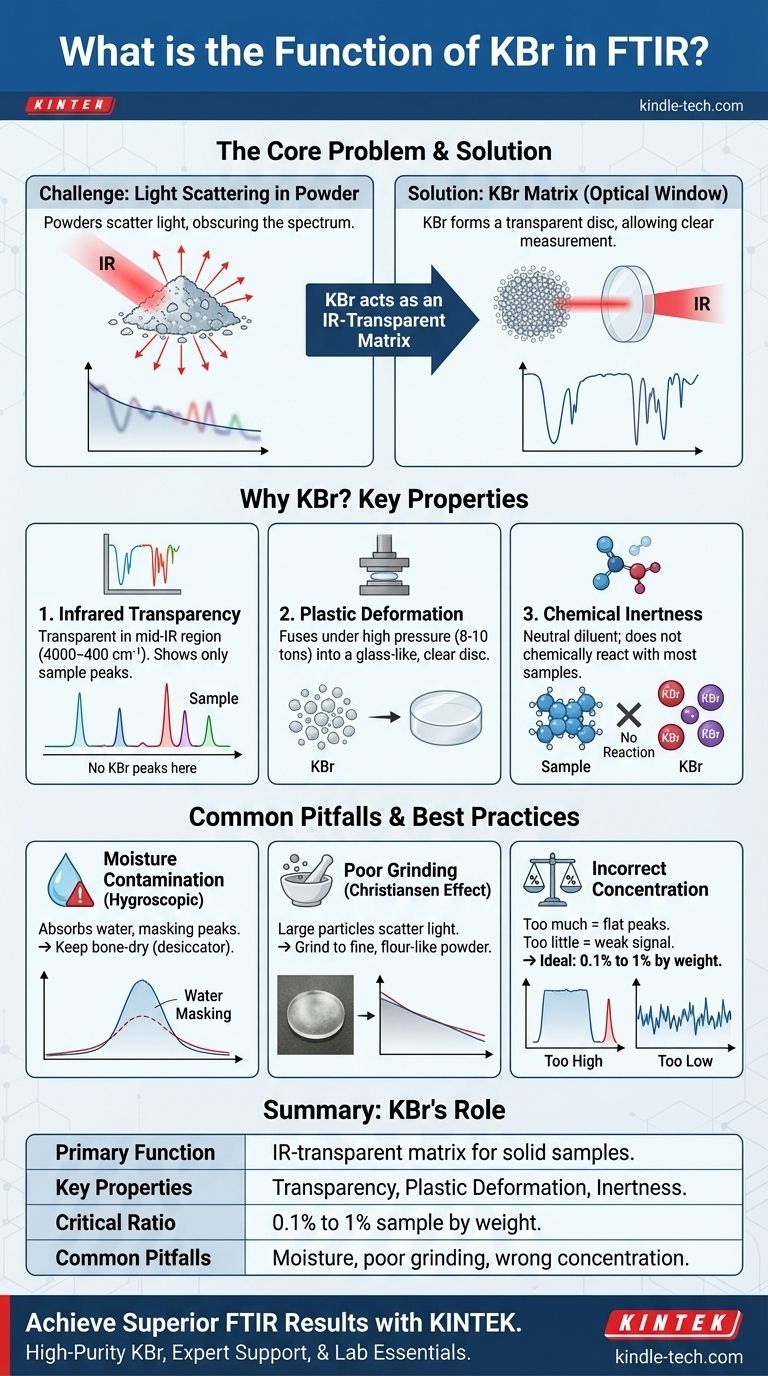In der analytischen Chemie dient Kaliumbromid (KBr) als spezielles Matrixmaterial zur Probenvorbereitung fester Proben für die Analyse mittels Fourier-Transform-Infrarot-Spektroskopie (FTIR). Die Probe wird fein mit KBr-Pulver vermahlen und unter hohem Druck zu einer dünnen, transparenten Scheibe oder einem „Pressling“ gepresst. Dieser Pressling fungiert als „Fenster“ im festen Zustand, das es dem Infrarotlicht ermöglicht, die Probe zu durchdringen, sodass deren molekulare Schwingungen gemessen werden können.
KBr ist kein chemisches Reagenz; es ist ein ideales optisches Fenster für die FTIR-Analyse im Festkörperbereich. Seine entscheidende Funktion ergibt sich aus seinen einzigartigen Eigenschaften: Es ist transparent für Infrarotlicht und kann zu einer glasartigen Scheibe gepresst werden, was die Lichtstreuung minimiert und eine klare, qualitativ hochwertige Messung der darin eingebetteten festen Probe ermöglicht.

Das Kernproblem: Analyse von Feststoffen mit Licht
Um die Funktion von KBr zu verstehen, müssen wir zunächst die grundlegende Herausforderung verstehen, Licht zur Analyse eines festen Pulvers zu verwenden.
Die Herausforderung der Lichtstreuung
Wenn man einen Infrarotstrahl direkt auf ein feines Pulver richtet, wird der größte Teil des Lichts in alle Richtungen gestreut, anstatt hindurchzutreten. Dieser Streueffekt verschleiert das wahre Absorptionsspektrum des Materials und führt zu einer qualitativ schlechten, unbrauchbaren Messung mit einer abfallenden Basislinie und verzerrten Peaks.
Die Notwendigkeit einer IR-transparenten Matrix
Um ein sauberes Spektrum zu erhalten, muss die feste Probe gleichmäßig in einem Medium dispergiert werden, das für Infrarotlicht transparent ist. Dieses Medium oder diese Matrix hält die Probenpartikel an Ort und Stelle und ermöglicht es dem IR-Strahl, für eine saubere Transmissionsmessung hindurchzutreten. Genau diese Rolle erfüllt KBr.
Warum Kaliumbromid (KBr) der Standard ist
KBr ist aufgrund einer spezifischen Kombination physikalischer Eigenschaften die gängigste Wahl für dieses Matrixmaterial.
Eigenschaft 1: Infrarot-Transparenz
Kaliumbromid ist ein Alkalihalogenidsalz, das im mittleren Infrarotbereich (ungefähr 4000 bis 400 cm⁻¹) keine eigenen molekularen Schwingungen aufweist. Das bedeutet, dass es im interessierenden Bereich der meisten Analysen kein IR-Licht absorbiert, wodurch sichergestellt wird, dass alle im Spektrum detektierten Absorptionspeaks nur zur Probe und nicht zur KBr-Matrix gehören.
Eigenschaft 2: Plastische Verformung
Unter hohem Druck (typischerweise 8–10 Tonnen) zeigt KBr-Pulver eine plastische Verformung oder „Kaltfluss“. Anstatt sich nur zu verdichten, verschmelzen die einzelnen Salzprismen miteinander, um eine homogene, glasartige, transparente Scheibe zu bilden. Diese Eigenschaft ist entscheidend für die Minimierung der Lichtstreuung und die Schaffung eines qualitativ hochwertigen optischen Fensters.
Eigenschaft 3: Chemische Inertheit
Für die meisten organischen und viele anorganische Verbindungen ist KBr ein chemisch inertes Wirtmaterial. Es dient als neutrales Verdünnungsmittel, das die Probe hält, ohne mit ihr zu reagieren, wodurch verhindert wird, dass die chemische Struktur der Probe während der Vorbereitung verändert wird.
Verständnis der Kompromisse und Fallstricke
Obwohl KBr der Standard ist, ist die richtige Technik unerlässlich. Mehrere häufige Probleme können die Qualität der Analyse beeinträchtigen.
Das Problem der Wasserverunreinigung
KBr ist stark hygroskopisch, was bedeutet, dass es leicht Feuchtigkeit aus der Atmosphäre aufnimmt. Wasser weist sehr starke, breite Absorptionsbanden im IR-Spektrum auf, die wichtige Peaks Ihrer Probe leicht überdecken können. Daher muss spektroskopisch reines KBr absolut trocken gehalten werden, typischerweise durch Lagerung in einem Exsikkator oder Trocknen im Ofen vor Gebrauch.
Schlechte Mahltechnik
Die von Ihnen bereitgestellte Referenz weist zu Recht darauf hin, dass das Mahlen für eine homogene Mischung unerlässlich ist. Wenn die Probe nicht fein genug mit dem KBr vermahlen wird, bleiben die Partikel groß genug, um Licht zu streuen. Dies führt zu einer stark abfallenden Basislinie im Spektrum, einem Phänomen, das als Christiansen-Effekt bekannt ist, und kann dazu führen, dass der resultierende Pressling trüb statt klar erscheint.
Falsche Probenkonzentration
Die Konzentration der Probe im KBr ist entscheidend. Eine typische Mischung enthält nur etwa 0,1 % bis 1 % Probe nach Gewicht.
- Zu viel Probe führt zu einer Totalsättigung, bei der die Peaks „abgeflacht“ sind, da bei diesen Frequenzen kein Licht mehr hindurchdringen kann.
- Zu wenig Probe führt zu einem schwachen, verrauschten Spektrum, bei dem die Peaks schwer von der Basislinie zu unterscheiden sind.
Die richtige Wahl für Ihr Ziel treffen
Das Verständnis der Prinzipien hinter der KBr-Methode ermöglicht es Ihnen, Probleme zu beheben und bei Bedarf Alternativen in Betracht zu ziehen.
- Wenn Ihr Hauptaugenmerk auf der qualitativ hochwertigen Analyse stabiler, fester Verbindungen liegt: Die KBr-Pressling-Methode ist der Goldstandard für die Erzeugung sauberer, scharfer und reproduzierbarer Transmissionsspektren.
- Wenn Ihre Probe feuchtigkeitsempfindlich ist oder hohem Druck nicht standhält: Ziehen Sie alternative Methoden in Betracht, wie die Herstellung einer Nujol-Verreibung oder die Verwendung der ATR-FTIR (Attenuated Total Reflectance), die die Probenoberfläche direkt analysiert.
- Wenn Sie mit trüben Presslingen oder einer abfallenden Basislinie zu kämpfen haben: Ihr Problem ist mit ziemlicher Sicherheit entweder eine Feuchtigkeitskontamination oder unzureichendes Mahlen. Stellen Sie sicher, dass Ihr KBr absolut trocken ist, und mahlen Sie die Mischung, bis sie ein feines, gleichmäßiges, mehlartiges Pulver ist.
Letztendlich verwandelt das Verständnis der Rolle von KBr es von einem einfachen Pulver in ein entscheidendes Werkzeug, um den molekularen Fingerabdruck Ihrer Probe aufzudecken.
Zusammenfassungstabelle:
| Wesentlicher Aspekt | Beschreibung |
|---|---|
| Hauptfunktion | Dient als IR-transparente Matrix für feste Proben in der FTIR-Spektroskopie. |
| Schlüsseleigenschaften | Infrarot-Transparenz, plastische Verformung unter Druck, chemische Inertheit. |
| Kritisches Verhältnis | Probenkonzentration typischerweise 0,1 % bis 1 % nach Gewicht in KBr. |
| Häufige Fallstricke | Feuchtigkeitsaufnahme (hygroskopisch), unzureichendes Mahlen, falsche Probenkonzentration. |
Erzielen Sie überlegene FTIR-Ergebnisse mit KINTEK's hochreinem KBr und fachkundiger Unterstützung.
Haben Sie Probleme mit trüben Presslingen, abfallenden Basislinien oder Feuchtigkeitsproblemen bei Ihrer FTIR-Analyse? KINTEK ist spezialisiert auf die Bereitstellung von Laborverbrauchsmaterialien und Geräten, die auf die analytische Chemie zugeschnitten sind. Unser spektroskopisch reines KBr wird hergestellt, um eine optimale Transparenz und einen minimalen Feuchtigkeitsgehalt zu gewährleisten, damit Sie jedes Mal klare, zuverlässige Spektren erhalten.
Wir unterstützen Labore wie Ihres mit:
- Hochreinem KBr: Optimiert für perfekte Presslingsbildung und minimale IR-Absorption.
- Technischer Beratung: Fachkundige Ratschläge zu Probenvorbereitungstechniken, um häufige Fallstricke zu vermeiden.
- Vollständiger Laborunterstützung: Von Verbrauchsmaterialien bis hin zu Pressgeräten – wir decken Ihre FTIR-Anforderungen ab.
Steigern Sie Ihre analytische Präzision – kontaktieren Sie noch heute unsere Experten, um Ihre spezifische Anwendung zu besprechen und die richtige KBr-Lösung für Ihr Labor zu finden.
Visuelle Anleitung

Ähnliche Produkte
- Laborhydraulikpresse Split Elektrische Laborpelletpresse
- kbr pelletpresse 2t
- Automatische hydraulische Pressenmaschine für Laborpellets für den Laboreinsatz
- Laborhandbuch Hydraulische Pelletpresse für Laboranwendungen
- Laborhydraulikpresse Labor-Pelletpresse für Knopfzellenbatterien
Andere fragen auch
- Was ist die KBr-Pressling-Methode? Ein vollständiger Leitfaden zur Probenvorbereitung für die IR-Spektroskopie
- Wie viel Kraft kann eine hydraulische Presse ausüben? Verständnis ihrer immensen Leistung und ihrer Konstruktionsgrenzen.
- Wie viel Druck kann eine hydraulische Presse erzeugen? Von 1 Tonne bis zu 75.000+ Tonnen Kraft
- Was ist der Zweck von KBr-Presslingen? Schalten Sie eine klare FTIR-Analyse von festen Proben frei
- Was ist die Verwendung von Kaliumbromid in der IR-Spektroskopie? Erzielen Sie eine klare Analyse fester Proben mit KBr-Presslingen



















